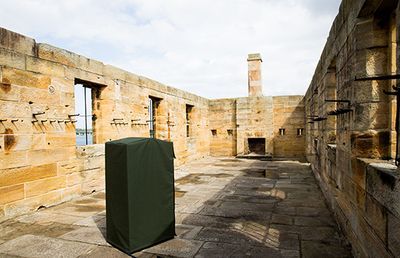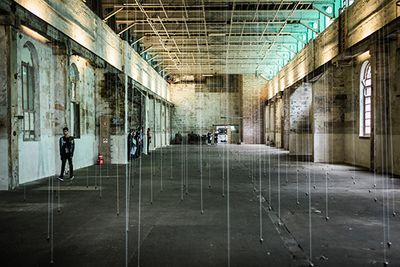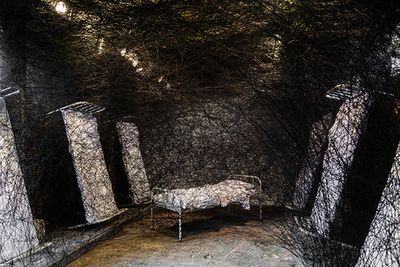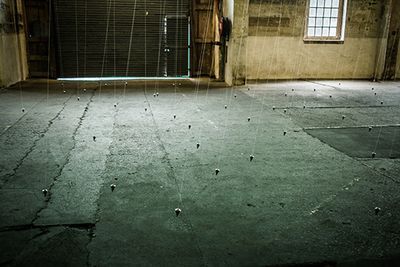On Cockatoo Island
 "Room of Rhythms", 2016, by Cevdet Erek. Photograph: Ben Symons
"Room of Rhythms", 2016, by Cevdet Erek. Photograph: Ben Symons
By MIKA ROSS-SOUTHALL
On holiday in Australia recently, one of the most bizarre places I came across was Cockatoo Island. It���s a UNESCO world heritage site in the middle of Sydney Harbour and, until Sunday, the host of Sydney���s twentieth art biennale. Before all this, though, it has had an extraordinary past.
Named after its sulphur-crested inhabitants, Cockatoo Island has, since 1839, been a prison for particularly bad convicts; an Industrial School for Girls, which took over the same prison buildings (you can still see crumbling-brick cells, ceramic sinks, faded tiles and childlike scribbles on the walls ��� imagine what it must have been like for those school children); and a ship-building yard, at its peak during the Second World War. The island then lay dormant for a decade in the 1990s, underwent restoration from 2001, and was opened to the public in 2007. There are camping areas now, too. (I���m not quite sold on that idea.)
Huge warehouses, surrounded by an array of spectacular industrial cranes, provide the main venues for the art work at this year's biennale ��� which is a mixed bag, not helped by the airport-style barriers (everywhere) with A4-paper signs telling you where you shouldn���t stand, walk or touch. (About as annoying as the biennale���s website, where brightly coloured words plummet intermittently down your screen.)
William Forsythe���s installation ���Nowhere and Everywhere at the Same Time, no. 2���, though, is a highlight. He���s filled a cavernous room with hundreds of synchronized, swinging plumb bobs on strings, which you���re invited to navigate through (no barriers here). Forsythe, a choreographer known for the experimental dance concepts ��� often using video projections, music, architecture and spoken word ��� that he developed with the Frankfurt Ballet and the Forsythe Company, calls this piece a ���choreographic object���. (The original ���Nowhere and Everywhere at the Same Time���, 2005, featured a solo dancer who moved in a field of pendulums suspended from the ceiling of an abandoned building on the High Line in New York.) Here, you instinctively weave your body in and out of the plumb bobs in time to their hypnotic sway (several got tangled when I wasn���t quick enough; along came an attendant to immediately clean up in my wake).
 "Nowhere and Everywhere at the Same Time, no. 2", 2013, by William Forsythe. Photograph: Bob Barrett
"Nowhere and Everywhere at the Same Time, no. 2", 2013, by William Forsythe. Photograph: Bob Barrett
Over in the old prison and school area, there���s a sinister site-specific work by the Japanese artist Chiharu Shiota. In ���Conscious Sleep��� (displayed in the former sleeping quarters), white steel bed frames are held up vertically by densely woven black thread; a powerful glimpse into the dark, nightmarish and claustrophobic minds of the inmates (and schoolgirls), perhaps. Back out into the bright daylight of the prison yard, the electricity cables stretching between the disused buildings look as though they���ve been just as artfully placed.
 "Conscious Sleep", 2009/2016, by Chiharu Shiota. Photograph: Ben Symons
"Conscious Sleep", 2009/2016, by Chiharu Shiota. Photograph: Ben Symons
Another wonderful surprise is Miguel ��ngel Rojas���s tessellated floor in the former Mess Hall. Only when up close (there���s a barrier to stop you treading on it) do you realize that the tiles are an illusion, instead made up of finely powdered charcoal, sand and lime. A rock sits in the centre. It���s a delicate challenge to Australia���s history of colonization (this kind of floor pattern is found in nineteenth-century Victorian architecture) and evokes the powerful connection to land felt by Aborigines.
Approaching the Guards House ��� the highest point on the Island ��� a thud-thud, thud-thud shakes the ground, like an eerie heartbeat that grows from a murmur to a bass-heavy boom. This is Cevdet Erek���s ���Room of Rhythms��� (see top image), a series of large speakers scattered in and around the now-roofless building, apparently to do with ��� the blurb tells us ��� the campaigns dating back to the 1850s to reduce the working week from forty-four hours to forty; each pulsation mirrors the workers��� unremitting protests that finally succeeded in 1947. But for me, even without this information, the atmosphere is affecting straight away. A reminder of all those beating hearts, mostly held captive, many of whom probably died on Cockatoo Island over the course of nearly two hundred years. Unlike them, I escaped on a city ferry a few hours later.
Peter Stothard's Blog
- Peter Stothard's profile
- 30 followers




